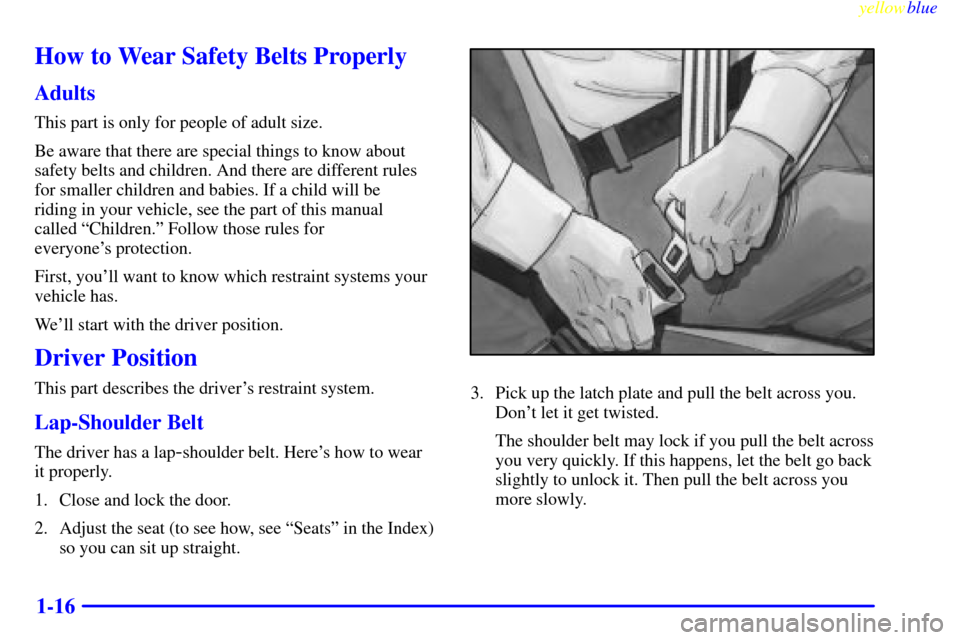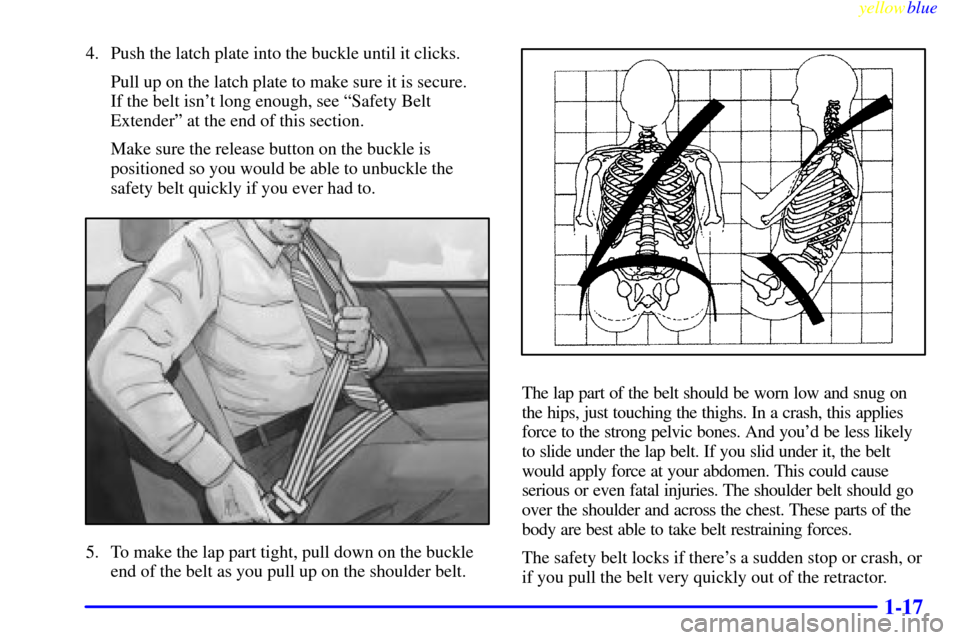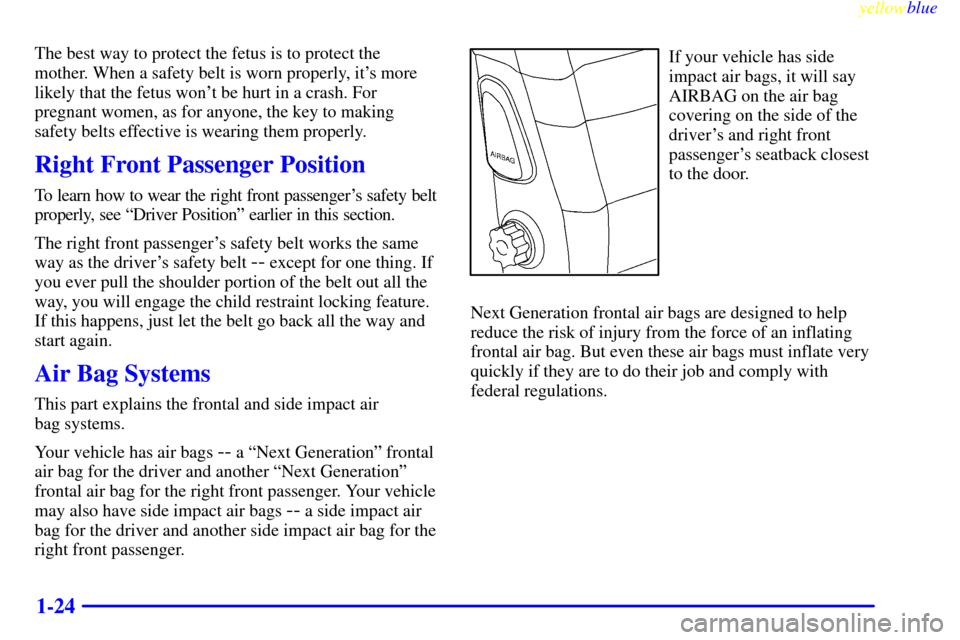Page 7 of 328
yellowblue
vii
For example,
these symbols
are used on an
original battery:
CAUTION
POSSIBLE
INJURY
PROTECT
EYES BY
SHIELDING
CAUSTIC
BATTERY
ACID COULD
CAUSE
BURNS
AVOID
SPARKS OR
FLAMES
SPARK OR
FLAME
COULD
EXPLODE
BATTERY
These symbols
are important
for you and
your passengers
whenever your
vehicle is
driven:
DOOR LOCK
UNLOCK
FASTEN
SEAT
BELTS
POWER
WINDOW
AIR BAG
These symbols
have to do with
your lamps:
MASTER
LIGHTING
SWITCH
TURN
SIGNALS
PARKING
LAMPS
HAZARD
WARNING
FLASHER
DAYTIME
RUNNING
LAMPS
FOG LAMPS
These symbols
are on some of
your controls:
WINDSHIELD
WIPER
WINDSHIELD
WASHER
WINDSHIELD
DEFROSTER
REAR
WINDOW
DEFOGGER
VENTILATING
FAN
These symbols
are used on
warning and
indicator lights:
ENGINE
COOLANT
TEMP
BATTERY
CHARGING
SYSTEM
BRAKE
COOLANT
ENGINE OIL
PRESSURE
ANTI-LOCK
BRAKES
Here are some
other symbols
you may see:
FUSE
LIGHTER
HORN
SPEAKER
FUEL
Vehicle Symbols
These are some of the symbols you may find on your vehicle.
Page 11 of 328

yellowblue
1-3
If a failure in the power supply system occurs, the power
seats can be manually adjusted by inserting the crank
handle into the slot located below the seat cushion, as
shown in the above illustration. Turn the crank handle
clockwise until you've reached your desired
seating position.
Note: Manually moving the seat requires turning the
crank handle many times.
The crank handle is provided in the tool kit located in
the trunk. To access, pull the red handle on the
passenger's side of the trunk.
Memory Seat and Mirrors
These buttons are located on the side of the driver's seat
closest to the door. They are used to program and recall
your desired memory settings.
To begin, adjust the driver's seat to a comfortable
position. Also adjust the interior and exterior mirrors.
Press memory button ªMº and memory button ª1º at the
same time and hold for five seconds.
Seat and mirror positions may be programmed for
two additional drivers by repeating the above steps and
pressing memory button ª2º or ª3º instead of
memory button ª1.º
Page 16 of 328
yellowblue
1-8
Folding the Rear Seat
With the rear folding seatbacks, you can carry long
cargo by folding down part or all of the rear seat.
Before you can fold the rear seat, you need to unlatch
the center buckle.
Insert a key or a similar
object into the slot as shown
to unlatch the buckle. Move
the belt to the side so it is
not in your way.
To unlock the rear seatback, press the pushbutton at the
top of the seat and fold the seatback forward. To return
the seat to the passenger position, lift up on the seatback
and push it rearward until it latches. After returning the
seat to the passenger position, pull forward on the
seatback to make sure it is locked into place.
Page 17 of 328
yellowblue
1-9
Return the safety belts to
their original positions so
they will be available for
rear seat passengers to use.
To do so, slide the buckle
into the latch as shown.
The panel behind the rear seat armrest also folds. Turn
the knob counterclockwise and pull the panel forward to
gain access to the trunk. When finished using the panel,
return it to its original position and turn the knob
clockwise to secure.
Page 24 of 328

yellowblue
1-16
How to Wear Safety Belts Properly
Adults
This part is only for people of adult size.
Be aware that there are special things to know about
safety belts and children. And there are different rules
for smaller children and babies. If a child will be
riding in your vehicle, see the part of this manual
called ªChildren.º Follow those rules for
everyone's protection.
First, you'll want to know which restraint systems your
vehicle has.
We'll start with the driver position.
Driver Position
This part describes the driver's restraint system.
Lap-Shoulder Belt
The driver has a lap-shoulder belt. Here's how to wear
it properly.
1. Close and lock the door.
2. Adjust the seat (to see how, see ªSeatsº in the Index)
so you can sit up straight.
3. Pick up the latch plate and pull the belt across you.
Don't let it get twisted.
The shoulder belt may lock if you pull the belt across
you very quickly. If this happens, let the belt go back
slightly to unlock it. Then pull the belt across you
more slowly.
Page 25 of 328

yellowblue
1-17
4. Push the latch plate into the buckle until it clicks.
Pull up on the latch plate to make sure it is secure.
If the belt isn't long enough, see ªSafety Belt
Extenderº at the end of this section.
Make sure the release button on the buckle is
positioned so you would be able to unbuckle the
safety belt quickly if you ever had to.
5. To make the lap part tight, pull down on the buckle
end of the belt as you pull up on the shoulder belt.
The lap part of the belt should be worn low and snug on
the hips, just touching the thighs. In a crash, this applies
force to the strong pelvic bones. And you'd be less likely
to slide under the lap belt. If you slid under it, the belt
would apply force at your abdomen. This could cause
serious or even fatal injuries. The shoulder belt should go
over the shoulder and across the chest. These parts of the
body are best able to take belt restraining forces.
The safety belt locks if there's a sudden stop or crash, or
if you pull the belt very quickly out of the retractor.
Page 26 of 328
yellowblue
1-18
Shoulder Belt Height Adjuster
Before you begin to drive, move the shoulder belt
adjuster to the height that is right for you.To move it down, press down on the arrow symbol and
move the height adjuster to the desired position. You can
move the adjuster up just by pushing up on the bottom
of the height adjuster. After you move the adjuster to
where you want it, try to move it down without pushing
in to make sure it has locked into position.
Adjust the height so that the shoulder portion of the
belt is centered on your shoulder. The belt should be
away from your face and neck, but not falling off
your shoulder.
Page 32 of 328

yellowblue
1-24
The best way to protect the fetus is to protect the
mother. When a safety belt is worn properly, it's more
likely that the fetus won't be hurt in a crash. For
pregnant women, as for anyone, the key to making
safety belts effective is wearing them properly.
Right Front Passenger Position
To learn how to wear the right front passenger's safety belt
properly, see ªDriver Positionº earlier in this section.
The right front passenger's safety belt works the same
way as the driver's safety belt
-- except for one thing. If
you ever pull the shoulder portion of the belt out all the
way, you will engage the child restraint locking feature.
If this happens, just let the belt go back all the way and
start again.
Air Bag Systems
This part explains the frontal and side impact air
bag systems.
Your vehicle has air bags
-- a ªNext Generationº frontal
air bag for the driver and another ªNext Generationº
frontal air bag for the right front passenger. Your vehicle
may also have side impact air bags
-- a side impact air
bag for the driver and another side impact air bag for the
right front passenger.
If your vehicle has side
impact air bags, it will say
AIRBAG on the air bag
covering on the side of the
driver's and right front
passenger's seatback closest
to the door.
Next Generation frontal air bags are designed to help
reduce the risk of injury from the force of an inflating
frontal air bag. But even these air bags must inflate very
quickly if they are to do their job and comply with
federal regulations.